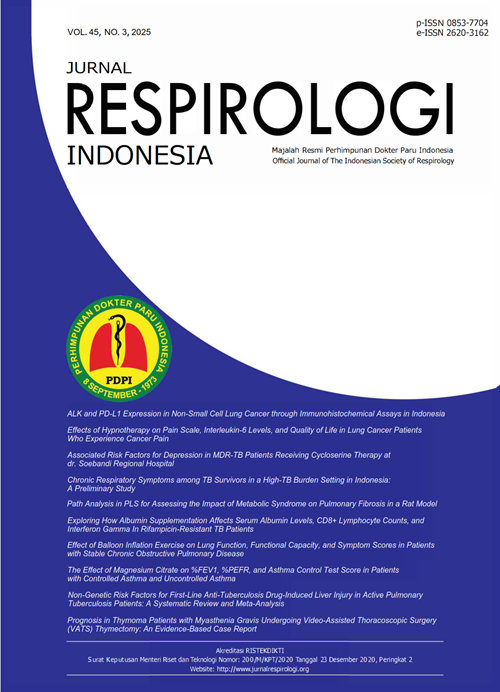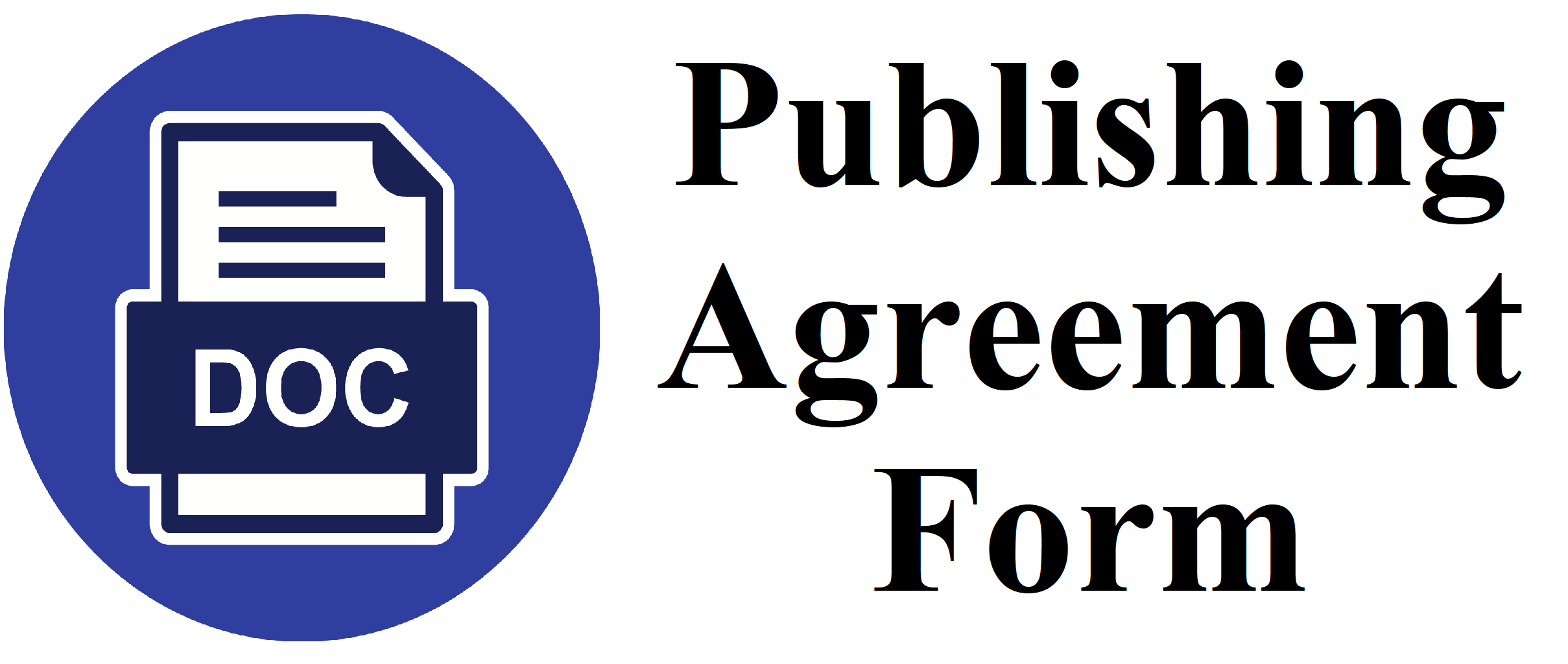Non-Genetic Risk Factors for First-Line Anti-Tuberculosis Drug-Induced Liver Injury in Active Pulmonary Tuberculosis Patients: A Systematic Review and Meta-Analysis
DOI:
https://doi.org/10.36497/jri.v45i3.693Keywords:
drug-induced liver injury, first-line anti-tuberculosis, pulmonary, risk factors, tuberculosisAbstract
Background: Tuberculosis is still one of the leading causes of poor health and death worldwide. Drug-induced liver injury (DILI) is an important and serious side effect of anti-tuberculosis treatment and can cause non-adherence of patients to the treatment. To reduce the possibility of patients developing DILI, the risk factors must be identified.
Methods: This systematic review was conducted based on the Preferred Reporting Items for Systematic Reviews and Meta-Analyses (PRISMA) 2020 statement. Inclusion and exclusion criteria were used to screen and filter the articles that were obtained from literature searching performed through several journal databases. The extracted data were analyzed qualitatively and quantitatively. The quality of each study was also assessed using the modified Newcastle Ottawa Scale (NOS). The protocol for this systematic review has been registered with PROSPERO CRD42022384892.
Results: The results showed that, of the 13 studies analyzed qualitatively, 11 studies with a total of 4,920 patients were selected for quantitative analysis. The factors analyzed and the results were female gender (OR=1.10; 95% CI=0.72-1.67; P=0.65), age over 40 years (OR=1.60; 95% CI=1.04-2.46; P=0.03), body mass index less than 18.5 kg/m2 (OR=0.96; 95% CI=0.52-1.79; P=0.9), active smoking (OR=0.71; 95% CI=0.34-1.49; P=0.36), frequent alcohol intake (OR=1.44; 95% CI=0.61-3.42; P=0.41), hepatitis B (OR=3.42; 95% CI=1.72-6.79; P<0.001]), and hepatitis C (OR=12.87; 95% CI=6.67-24.86; P<0.00001]).
Conclusion: In conclusion, the evidence from this review suggests that older age, hepatitis B, and hepatitis C are significant risk factors thought to increase the incidence of DILI in active pulmonary tuberculosis patients taking first-line anti-tuberculosis regimens.
Downloads
References
1. World Health Organization. Global tuberculosis report 2022. Geneva; 2022.
2. Gupta RK, Lucas SB, Fielding KL, Lawn SD. Prevalence of tuberculosis in post-mortem studies of HIV-infected adults and children in resource-limited settings: A systematic review and meta-analysis. AIDS. 2015;29(15):1987–2002.
3. MacNeil A, Glaziou P, Sismanidis C, Maloney S, Floyd K. Global epidemiology of tuberculosis and progress toward achieving global targets — 2017. MMWR Morb Mortal Wkly Rep. 2019;68(11):263–6.
4. Directorate General of Prevention and Disease Control. Tuberculosis control in Indonesia 2022. Indonesia; 2022.
5. Jiang F, Yan H, Liang L, Du J, Jin S, Yang S, et al. Incidence and risk factors of anti-tuberculosis drug induced liver injury (DILI): Large cohort study involving 4652 Chinese adult tuberculosis patients. Liver International. 2021;41(7):1565–75.
6. Wang N, Chen X, Hao Z, Guo J, Wang X, Zhu X, et al. Incidence and temporal trend of antituberculosis drug-induced liver injury: A systematic review and meta-analysis. J Trop Med. 2022;2022:8266878.
7. Zhong T, Fan Y, Dong XL, Guo X, Wong KH, Wong WT, et al. An investigation of the risk factors associated with anti-tuberculosis drug-induced liver injury or abnormal liver functioning in 757 patients with pulmonary tuberculosis. Front Pharmacol. 2021;12:708522.
8. Saha A, Margaret Shanthi FX, Blessed Winston A, Das S, Kumar A, Michael JS, et al. Prevalence of hepatotoxicity from antituberculosis therapy: A five-year experience from South India. J Prim Care Community Health. 2016;7(3):171–4.
9. Natarajan S, Subramanian P. Evaluation of drug induced liver injury due to anti tuberculous drugs in directly observed daily therapy. 2016;48(suppl 60):PA2670.
10. Molla Y, Wubetu M, Dessie B. Anti-tuberculosis drug induced hepatotoxicity and associated factors among tuberculosis patients at selected hospitals, Ethiopia. Hepat Med. 2021;13:1–8.
11. Abbaspour F, Hasannezhad M, Khalili H, SeyedAlinaghi S, Jafari S. Managing hepatotoxicity caused by anti-tuberculosis drugs: A comparative study of approaches. Arch Iran Med. 2024;27(3):122–6.
12. Kramer ON, Albrecht J. Clinical presentation of terbinafine-induced severe liver injury and the value of laboratory monitoring: A Critically appraised topic. British Journal of Dermatology. 2017;177(5):1279–84.
13. Yani DI, Juniarti N, Lukman M. Factors related to complying with anti-TB medications among drug-resistant tuberculosis patients in Indonesia. Patient Prefer Adherence. 2022;16:3319–27.
14. Saputri IN, Munthe EL. Multidrug-resistant tuberculosis and implementation of control measures in Ketapang District, West Borneo, Indonesia. Jurnal Respirologi Indonesia. 2020;40(1):1–10.
15. Bea S, Lee H, Kim JH, Jang SH, Son H, Kwon JW, et al. Adherence and associated factors of treatment regimen in drug-susceptible tuberculosis patients. Front Pharmacol. 2021;12:625078.
16. Latief M, Dar WR, Sofi N, Dar IA, Kasana B, Hussain M, et al. Novel risk factors and early detection of anti tubercular treatment induced liver injury—Looking beyond American Thoracic Society Guidelines. Indian Journal of Tuberculosis. 2017;64(1):26–32.
17. Lang SM, Al-Nemnem E, Schiffl H. Anti-tuberculosis drug induced liver injury and ursodeoxycholic acid. J Tuberc Res. 2020;8(1):89–92.
18. Björnsson ES. Clinical management of patients with drug-induced liver injury (DILI). United European Gastroenterol J. 2021;9(7):781–6.
19. Page MJ, McKenzie JE, Bossuyt PM, Boutron I, Hoffmann TC, Mulrow CD, et al. The PRISMA 2020 statement: An updated guideline for reporting systematic reviews. The BMJ. 2021;372:n71.
20. Wells G, Shea B, O’Connell D, Peterson J, Welch V, Losos M, et al. The Newcastle-Ottawa Scale (NOS) for assessing the quality if nonrandomized studies in meta-analyses. The Ottawa Hospital Research Institute. 2012.
21. Ilham AF, Andini SR, Afladhia HL, Rakasiwi MID, Burhan E. Risk factors for viral hepatitis in pulmonary tuberculosis patients undergoing treatment: A systematic review and meta-analysis. Narra J. 2024;4(3):e1242.
22. Abbasi MA hmad, Ahmed N, Suleman A, Zaman H, Tariq S, Anwar SA bbas, et al. Common risk factors for the development of anti tuberculosis treatment induced hepatotoxicity. J Ayub Med Coll Abbottabad. 2014;26(3):384–8.
23. Baghaei P, Tabarsi P, Chitsaz E, Saleh M, Marjani M, Shemirani S, et al. Incidence, clinical and epidemiological risk factors, and outcome of drug-induced hepatitis due to antituberculous agents in new tuberculosis cases. Am J Ther. 2010;17(1).
24. Cavaco MJ, Alcobia C, Oliveiros B, Mesquita LA, Carvalho A, Matos F, et al. Clinical and genetic risk factors for drug‐induced liver injury associated with anti‐tuberculosis treatment—A study from patients of Portuguese Health Centers. J Pers Med. 2022;12(5):790.
25. Chien JY, Huang RM, Wang JY, Ruan SY, Chien YJ, Yu CJ, et al. Hepatitis C virus infection increases hepatitis risk during anti-tuberculosis treatment. International Journal of Tuberculosis and Lung Disease. 2010;14(5):616–21.
26. Fauzi AR, Shah A, Rathor MY, Satwi S. Risk factors for anti tuberculous drugs induced hepatitis: A prospective survey from a chest clinic in a general hospital. Med J Malaysia. 2004;59(1):72–7.
27. Khoharo HK, Ansari S, Siddiqui AA, Qureshi F. Standard antituberculosis drug induced hepatotoxicity: Do the risk factors matter? Journal of the Liaquat University of Medical and Health Sciences. 2010;9(2):84–7.
28. Lomtadze N, Kupreishvili L, Salakaia A, Vashakidze S, Sharvadze L, Kempker RR, et al. Hepatitis C virus co-infection increases the risk of anti-tuberculosis drug-induced hepatotoxicity among patients with pulmonary tuberculosis. PLoS One. 2013;8(12):e83892.
29. Pande JN, Singh SPN, Khilnani GC, Khilnani S, Tandon RK. Risk factors for hepatotoxicity from antituberculosis drugs: A case-control study. Thorax. 1996;51(2):132–6.
30. Tao B, Yang M, Chen H, Pan H, Liu W, Yi H, et al. Association of ABO blood group and antituberculosis drug-induced liver injury: A case-control study from a Chinese Han population. J Clin Pharm Ther. 2020;45(4):638–45.
31. Teleman MD, Chee CBE, Earnest A, Wang YT. Hepatotoxicity of tuberculosis chemotherapy under general programme conditions in Singapore. International Journal of Tuberculosis and Lung Disease. 2002;6(8):699–705.
32. Wang JY, Liu CH, Hu FC, Chang HC, Liu JL, Chen JM, et al. Risk factors of hepatitis during Anti-tuberculous treatment and implications of hepatitis virus load. Journal of Infection. 2011;62(6):448–55.
33. Song JH, Yoon SY, Park TY, Heo EY, Kim DK, Chung HS, et al. The clinical impact of drug-induced hepatotoxicity on anti-tuberculosis therapy: A case control study. Respir Res. 2019;20(1):283.
34. Soedarsono S, Riadi ARW. Tuberculosis drug-induced liver injury. Jurnal Respirasi. 2020;6(2):49–54.
35. Kuna L, Bozic I, Kizivat T, Bojanic K, Mrso M, Kralj E, et al. Models of drug induced liver injury (DILI) – Current issues and future perspectives. Curr Drug Metab. 2018;19(10):830–8.
36. Saraiva M, Vieira P, O’Garra A. Biology and therapeutic potential of interleukin-10. Journal of Experimental Medicine. 2020;217(1):e20190418.
37. Liu W, Zeng X, Liu Y, Liu J, Li C, Chen L, et al. The immunological mechanisms and immune-based biomarkers of drug-induced liver injury. Front Pharmacol. 2021;12:723940.
38. Lucena MI, Sanabria J, García-Cortes M, Stephens C, Andrade RJ. Drug-induced liver injury in older people. Lancet Gastroenterol Hepatol. 2020;5(9):862–74.
39. Mehta P, Reddivari AKR. Hepatitis. Treasure Island (FL): StatPearls Publishing; 2020. 1–19 p.
40. Kim WS, Lee SS, Lee CM, Kim HJ, Ha CY, Kim HJ, et al. Hepatitis C and not Hepatitis B virus is a risk factor for anti-tuberculosis drug induced liver injury. BMC Infect Dis. 2016;16.
41. Barathan M, Riazalhosseini B, Iyadorai T, Vellasamy KM, Vadivelu J, Chang LY, et al. Comparative expression of pro-inflammatory and apoptotic biosignatures in chronic HBV-infected patients with and without liver cirrhosis. Microb Pathog. 2021;161(Pt A):105231.
42. Chou C, Veracruz N, Chitnis AS, Wong RJ. Risk of drug-induced liver injury in chronic hepatitis B and tuberculosis co-infection: A systematic review and meta-analysis. J Viral Hepat. 2022;29(12):1107–14.
Downloads
Published
Issue
Section
License
Copyright (c) 2025 Ahmad Fadhil Ilham, Ris Raihan Felim, Fadhian Akbar, Erlina Burhan

This work is licensed under a Creative Commons Attribution-ShareAlike 4.0 International License.
- The authors own the copyright of published articles. Nevertheless, Jurnal Respirologi Indonesia has the first-to-publish license for the publication material.
- Jurnal Respirologi Indonesia has the right to archive, change the format and republish published articles by presenting the authors’ names.
- Articles are published electronically for open access and online for educational, research, and archiving purposes. Jurnal Respirologi Indonesia is not responsible for any copyright issues that might emerge from using any article except for the previous three purposes.
















